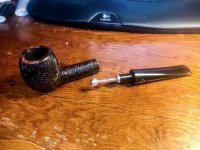I prefer an open draw with a shank measurement at around 4.0-4.5 mm. In my experience the pipe will smoke cool and dry and they don't produce a pipe that gurgles. I have a screw in stem in a Meer and it is a piece of shit. It is an SMS which is not supposed to be a bad meer. I bought it before I knew anything about shank dimensions and screw on stems. Luckily it wasn't that long before I learned what I enjoy smoking.
The Lee Hidden Screw Stem
- Thread starter Briar Lee
- Start date
You are using an out of date browser. It may not display this or other websites correctly.
You should upgrade or use an alternative browser.
You should upgrade or use an alternative browser.
SmokingPipes.com Updates
Watch for Updates Twice a Week
A Lee was the highest priced regularly cataloged pipe in the world, with the $25 Five Star Grade.
Nope, although I suppose this can be considered a definitional question (I can easily see the phrase "regularly catalogued" becoming a rabbit hole). Before sharing an illustrative list it's worth noting two things. First, the survival of so few Five stars indicates that few were made; if we extend Lee the courtesy of saying a pipe rarely made is "regularly catalogued" since it appears in catalogs of the time then we must extend the same courtesy to other manufacturers. Second, the $25 price point was a bit of a marketing trophy, and your implication that it was occupied by Lee in solitary splendor is incorrect.
Since Pipes by Lee were preeminently an American product priced in dollars I'll limit myself to ten other $25 pipes available in the American market in the late 1940s:
1) Comoy's: Extraordinaire Blue Riband $25, and the Specimen Straight Grain $25
2) Empire Briar Pipe Co: Emperor Straight Grain $25
3) Kaywoodie: Centennial $25, and the Straight Grain $25
4) Marxman Pipes: The Four Hundred $25
5) Rogers Imports: Rarity line $10-25
6) L & H Stern: Special Make line $12.50-25
7) John Surrey: Supreme $25
8) Dick Swift Pipes: Personal Selection $25
One final observation: one price point down ($10-20) was where the real "high grade pipe" action was at that time. It was crowded with models, and if I wanted to compile a list of pipes which competed with the Lee Three star pipe, which I suspect was the bread and butter item for the company, it would be much, much longer.
Something I haver never heard of on here in all of these years, is that stingers actually do anything positive.
Has anyone actually smoked a pipe with the stinger intact? I definitely haven't, nor would I buy a pipe that has one, but besides hindering a pipecleaner, do they gurgle like I imagine they would. Does anyone actually prefer smoking a pipe with a stinger intact?
Has anyone actually smoked a pipe with the stinger intact? I definitely haven't, nor would I buy a pipe that has one, but besides hindering a pipecleaner, do they gurgle like I imagine they would. Does anyone actually prefer smoking a pipe with a stinger intact?
I appreciate not only having a good stinger on a pipe, but... I prefer 9mm filters as well.Something I haver never heard of on here in all of these years, is that stingers actually do anything positive.
Has anyone actually smoked a pipe with the stinger intact? I definitely haven't, nor would I buy a pipe that has one, but besides hindering a pipecleaner, do they gurgle like I imagine they would. Does anyone actually prefer smoking a pipe with a stinger intact?
Why the stinger?
If the pipe is smoked as it should be, slowly and cooly, the stinger works as intended and acts as another barrier between me and liquid tar.
Of course, because I can be sure many contradictory replies will follow, understand that stingers are not necessary and yada yada yada.
I won't defend the use of a stinger, but I do have one request of people who purchase vintage pipes:
Please DO NOT cut off the Kaywoodie stingers. It just is wrong and gives the next person a pipe that is not designed as intended.
Of course, while in the owners' hands, they may of course do as they wish.
When I buy an old Kaywoodie, I understand it has a stinger. When I smoke it, I do so knowing that the stinger is there. I keep it clean and it does what it is suppose to do. Packing has more to do with gurgle.
If I don't want a pipe with a stinger then I smoke a pipe designed without one.
It's that easy.
I have a Pipe by Lee on its way. Someone, maybe Briar Lee, himself, removed the stinger. I hope @Briar Lee will send me one of his many cast aways in his little wooden box so that I can fix one on to it.
Do any new pipes use stingers today?
It was a long decline in popularity, from Kaywoodie’s late twenties patent on the Drinkless stinger to where every basket pipe to top end luxury pipes, all had metal stingers.
I think even Kaywoodie dropped the stinger.
Kaywoodie also patented the Syncro Stem (screw stem) in the early 1930s.
The stingers, if designed right, seemed to work, based on how quickly a Kaywoodie or Lee will gunk up a stinger with tars.
And the early Kaywoodies with large balls seemed to truly trap water, from the smoke stream. You can unscrew one and shake off the drops they collect.
All I know is I pull the stingers from all my old pipes that had a removable stinger because I want all those delicious tars in my mouth, along with more Vitamin N.
In my opinion Lee had the best stinger, largely due to the fact it’s removable.
Ksywoodie and Dr Grabow had a good screw stem in the 1955 patent Adjustomatic stems, that easily synchronized.
But I can synchronize a Lee screw stem with a pair of pliers and patience, if it’s not had tars build up freezing the rear screw in place.
A new Lee pipe came with the stem slightly left of center, to allow for wear. I usually leave them alone, if they are this good.
View attachment 102860View attachment 102861
Stingers seem like a thing of the past. Also a thing of the past seems to be the competition to make a pipe the easiest smoking pipe that won't hurt the smoker now matter how much they pretend to be Thomas the Train with their pipe. It seems like a few of the "gimmicks" carried over and many didn't. Doesn't seem like one problem with stingers is they aren't obvious from looking at the pipe. Like for instance a falcon grabs ones attention and you know you're getting something different. Where as a stinger might disappoint the person buying the pipe who didn't know it was there. Though I've been thinking of getting an old estate with a stinger to see what difference they make.
Also seems like pipes where more heavily advertised and sold by catalog more often. Where these days it's more look online or at a tobacconists. Where having a feature that might be a benefit or not that the average buyer isn't aware of isn't going to increase sales. Few will know to even look for that feature.
Also seems like pipes where more heavily advertised and sold by catalog more often. Where these days it's more look online or at a tobacconists. Where having a feature that might be a benefit or not that the average buyer isn't aware of isn't going to increase sales. Few will know to even look for that feature.
I always like to learn more about old pipes, thank you.Nope, although I suppose this can be considered a definitional question (I can easily see the phrase "regularly catalogued" becoming a rabbit hole). Before sharing an illustrative list it's worth noting two things. First, the survival of so few Five stars indicates that few were made; if we extend Lee the courtesy of saying a pipe rarely made is "regularly catalogued" since it appears in catalogs of the time then we must extend the same courtesy to other manufacturers. Second, the $25 price point was a bit of a marketing trophy, and your implication that it was occupied by Lee in solitary splendor is incorrect.
Since Pipes by Lee were preeminently an American product priced in dollars I'll limit myself to ten other $25 pipes available in the American market in the late 1940s:
1) Comoy's: Extraordinaire Blue Riband $25, and the Specimen Straight Grain $25
2) Empire Briar Pipe Co: Emperor Straight Grain $25
3) Kaywoodie: Centennial $25, and the Straight Grain $25
4) Marxman Pipes: The Four Hundred $25
5) Rogers Imports: Rarity line $10-25
6) L & H Stern: Special Make line $12.50-25
7) John Surrey: Supreme $25
8) Dick Swift Pipes: Personal Selection $25
One final observation: one price point down ($10-20) was where the real "high grade pipe" action was at that time. It was crowded with models, and if I wanted to compile a list of pipes which competed with the Lee Three star pipe, which I suspect was the bread and butter item for the company, it would be much, much longer.
Lee was something of a raconteur, but he really wasn’t an out and out charlatan.
After 1946 Lee drops the $3.50 One Star, and the customer got a catalog of shapes, and most (not all) you select a shape and send $5,$10,$15,or $25. So only by that measure, was a Lee the highest priced regularly cataloged pike in the world. But the overwhelming majority of customers seemed to select the Three Star grade.
All were “A Limited Edition”. Probably limited to as many as he could sell.
I think the claim of limited edition was based on small changes to the stinger.
I might count them, someday, but I own at least 60 Lee pipes.
Not a single one, is a stunning, oh my God look at that, outrageously beautiful pipe.
Not even my one 5 point star Five Star Grade had the briar polished out to a high polish. Many seem almost matte.
But I just love, how they all smoke, look, hang, clench, and feel to hold in your hand. Even my late push stem stamped star Lees are high quality pipes.
Compared to top end English pipes, Kaywoodies and Lees after WW2 are sort of like comparing American luxury cars to English luxury cars. Ours were made to American tastes. Theirs are more handmade, and quite frankly, better.
But if you wanted to take your new Packard and drive to Las Vegas, or go off with your Shriner buddies to tear up a hotel,,,,Lee was the better Kaywoodie.
There are terrible, awful, cheap Kaywoodies. I own some.
All Pipes by Lee, were considered by their first owners as a high dollar luxury pipe, because by American standards, they were.









